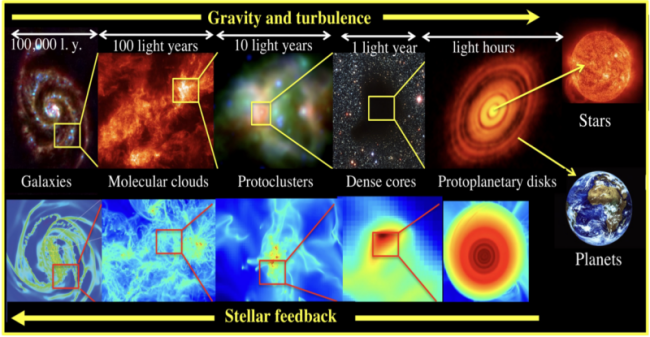Modern astronomy reveals that our Universe started out extremely simple. It was almost perfectly uniform with only very small density fluctuations. Today, we live in a different world. More than 13 billion years after the big bang the Universe is deeply organized on all scales, ranging from large galaxy clusters to stars and planets and down to the level of complex organic molecules. In this hierarchy of comic structure, galaxies and the stars and planets they harbor within, are fundamental building blocks. Understanding their origin and the physical processes that govern their dynamical evolution is one of the key challenges in modern science.
Indeed, we currently witness a paradigm shift in this field of research. While previous models assume the Milky Way and the structures within typically persist in equilibrium and only slowly evolve over secular timescales, we now know that the evolution of the interstellar medium (ISM) and the formation of stars and planets is a highly dynamical process, which couples a wide range of scales in space, time, and energy through a large number of different feedback loops. We now understand that a comprehensive model of our Galaxy will need to consider it as one single complex ecosystem, where large parts evolve far from equilibrium and which exhibits highly non-linear dynamical behavior. It requires a statistical approach together with a complete inventory of the different Galactic environments and knowledge of their possible variations across all scales.
It is well established that a complex cycle of matter and energy takes place within galaxies. The complex flow patterns in the multi-scale multi-phase ISM are the central engine of galaxy evolution, they determine where and at what rate stars and planets form in our Milky Way. Stars build up in regions of the ISM that become unstable under their own weight. During this contraction, the density increases by more than 25 orders of magnitude and the temperature rises by a factor of a million. The process comes to an end when nuclear burning processes set in and provide stability: a star is born. Star formation is controlled by the intricate interplay between the self-gravity of the ISM and various opposing agents, such as supersonic turbulence, magnetic fields, radiation and gas pressure. The evolution is modified by the thermodynamic response of the gas, which is determined by the balance between heating and cooling, which in turn depends on the chemical composition of the material and the detailed interaction of gas and dust with the interstellar radiation field. The local process of stellar birth is linked to the large-scale dynamics in the Galaxy, such as spiral arms or perturbations from satellite galaxies. Stellar feedback is also key. Radiation, winds, and supernova explosions determine the chemical and thermal state of the ISM, which in turn affects subsequent star formation via a hierarchy of feedback loops. Stars also synthesize heavy elements, which are eventually mixed back into the ISM as stars die. Without this perpetual matter cycle the chemical complexity we observe today on Earth and around other planets would not be possible.
In this highly complex environment, we can identify several key object classes. These are giant molecular clouds, which constitute the dense phase of the ISM, star clusters that form in their interior, dense cores on yet smaller scales, that collapse under their own gravitational weight to build individual stars, surrounded by planet forming disks. Understanding this hierarchy of structures is a cornerstone for our knowledge of cosmic evolution and a prerequisite to uncover the story of our place in the Universe. As such the field is receiving considerable attention worldwide and numerous teams are actively working both on the observational and theoretical sides.




